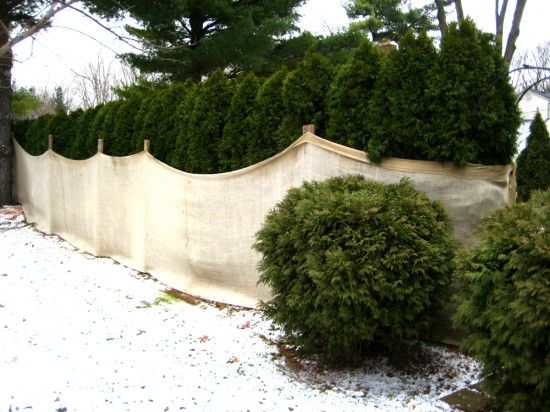- September 18, 2024
- Posted by: wellcoindustries
- Categories: Burlap, Erosion Control
Introduction
Winter can be a challenging time for gardeners, especially when it comes to protecting potted plants from the harsh, cold weather. Potted plants are more vulnerable to freezing temperatures because their roots lack the natural insulation provided by the ground. Wrapping your plants in burlap is an effective way to shield them from the cold, prevent root damage, and ensure they thrive through the winter months. In this step-by-step guide, we will explore exactly how to wrap a potted plant in burlap for winter, ensuring your plants remain healthy and safe.

Why Protect Potted Plants in Winter?
Potted plants are more susceptible to cold weather because they lack the ground insulation that garden plants have. The roots of potted plants are exposed to lower temperatures, which can cause them to freeze, suffer damage, or even die. Protecting these plants during winter is essential for their survival. When temperatures drop, roots can become brittle and are more likely to crack or break. Additionally, frost can cause soil to expand, potentially damaging the pot or disrupting the plant’s growth.
Wrapping potted plants in burlap provides a layer of insulation that helps to maintain a more stable temperature around the roots. Burlap is breathable, allowing air circulation while preventing the plant from overheating or becoming too moist. This simple, natural method is highly effective in protecting plants against frost, wind, and snow.
What You’ll Need to Wrap a Potted Plant in Burlap
Before you begin, gather the following materials to wrap your potted plant in burlap:
- Burlap fabric: Choose a sufficient length to cover the entire plant and pot.
- Twine or rope: For securing the burlap in place.
- Stakes or wooden dowels: Optional, for supporting taller plants.
- Scissors: For cutting the burlap to the required size.
- Mulch or leaves: Optional, to provide extra insulation around the base.
When selecting burlap, look for a high-quality, dense weave that will provide adequate protection against the cold. Ensure the burlap is free from any synthetic coatings that could prevent air circulation. For twine, natural fibers such as jute or sisal are ideal as they won’t damage the plant.
Step-by-Step Guide on How to Wrap a Potted Plant in Burlap
Step 1: Preparing the Plant and Pot for Winter
- Before wrapping, water the plant lightly. Avoid overwatering, as excess moisture can freeze and harm the roots.
- Remove any dead or diseased leaves and branches to prevent mold and pests during winter.
- Place the plant in a location sheltered from strong winds but still exposed to natural light.
Step 2: Measuring and Cutting the Burlap
- Measure the height and circumference of your plant and pot to determine how much burlap you will need. Cut the burlap accordingly, leaving extra material for overlapping and secure wrapping.
- For taller plants, cut an additional piece to cover the top of the plant, ensuring complete coverage.
Step 3: Wrapping the Plant Securely
- Wrap the burlap around the pot and the lower part of the plant first, securing it tightly with twine or rope. Make sure the base is covered to protect the roots.
- For taller plants, use stakes or dowels to support the burlap, especially if the plant is top-heavy or in an area exposed to wind.
Step 4: Securing the Burlap with Twine or Ties
- Once the plant and pot are covered, use twine to tie the burlap in place. Start at the base and work your way up, ensuring the burlap is snug but not too tight to avoid damaging the plant.
- If necessary, use additional ties at different heights to keep the burlap from shifting or loosening during the winter.
Step 5: Additional Tips for Added Protection
- Add a layer of mulch or leaves around the base of the plant inside the burlap wrap to provide extra insulation and prevent soil from freezing.
- Consider placing the wrapped plant in a location with additional protection, such as near a building wall or under an awning, to minimize exposure to extreme conditions.
Common Mistakes to Avoid When Wrapping Plants in Burlap
When wrapping potted plants in burlap for winter, avoid these common mistakes:
- Wrapping Too Tightly: This can restrict air circulation and damage the plant. Ensure the burlap is snug but not constricting.
- Not Covering the Base: The base of the plant, especially the pot, should be covered to protect the roots from frost.
- Using Plastic Instead of Burlap: Unlike burlap, plastic traps moisture and can cause mold or rot. Always use breathable materials like burlap.
- Ignoring Watering Needs: Even in winter, plants may need some watering. Check moisture levels periodically and water sparingly as needed.
Benefits of Using Burlap Over Other Materials
Using burlap has several advantages over other materials:
- Breathability: Burlap allows air to circulate, preventing mold and mildew that can occur with plastic or other non-breathable materials.
- Natural Insulation: Burlap provides a natural insulating layer that helps maintain a stable temperature around the plant.
- Environmentally Friendly: Burlap is biodegradable and sustainable, unlike plastic which can be harmful to the environment.
- Versatility: Burlap is easy to work with, lightweight, and can be reused for multiple seasons.
Conclusion
Wrapping your potted plants in burlap for winter is an effective way to protect them from the cold, frost, and wind. By following this step-by-step guide, you can ensure that your plants stay healthy and thrive through the harsh winter months. Remember, the key is to use breathable materials like burlap, secure the wrap properly, and avoid common mistakes that could harm your plants. Start preparing your potted plants today to give them the best chance of surviving and flourishing in the coming seasons.
Ready to protect your potted plants? Grab your burlap, follow these steps, and keep your garden healthy all winter long!
